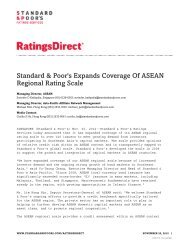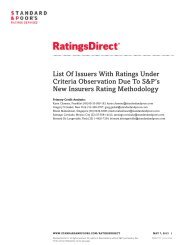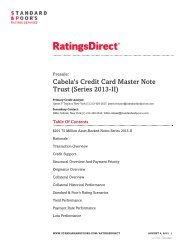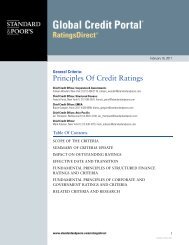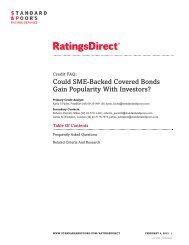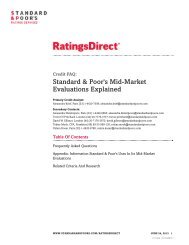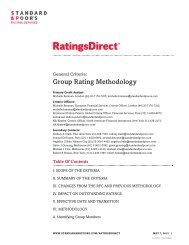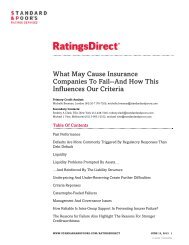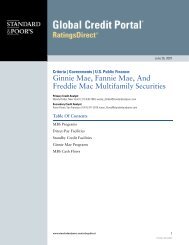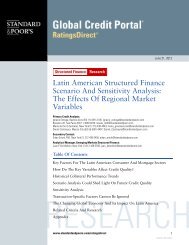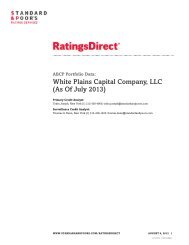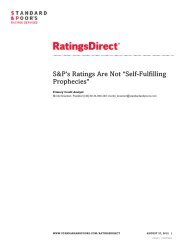Criteria for Rating German Residential Mortgage ... - Standard & Poor's
Criteria for Rating German Residential Mortgage ... - Standard & Poor's
Criteria for Rating German Residential Mortgage ... - Standard & Poor's
Create successful ePaper yourself
Turn your PDF publications into a flip-book with our unique Google optimized e-Paper software.
<strong>Criteria</strong> Structured Finance RMBS: <strong>Criteria</strong> <strong>for</strong> <strong>Rating</strong> <strong>German</strong> <strong>Residential</strong> <strong>Mortgage</strong>-Backed Securities<br />
Note that <strong>Standard</strong> & <strong>Poor's</strong> considers family homes with an attached rental flat to be owner-occupied and as such<br />
do not attract the additional <strong>for</strong>eclosure risk of a letting-only property.<br />
Loan Size<br />
Large loans are considered to have more inherent risk than smaller loans owing to the increased sensitivity of these<br />
borrowers to changes in their financial situation in times of recession. Jumbo loans are defined as loans with a<br />
balance of more than €400,000. This limit will be adjusted on an ongoing basis to reflect regional price differences.<br />
Geographic Concentration<br />
If a pool is not suitably diversified by region, a local economic downturn can adversely affect the losses in the<br />
mortgage pool. <strong>Standard</strong> & <strong>Poor's</strong> generally considers the effect of regional concentrations on <strong>for</strong>eclosure<br />
frequencies on a case-by-case basis. In this analysis, the proportion of the pool in each geographic area is compared<br />
with the population distribution of <strong>German</strong>y as a whole. If they correspond approximately, typically no additional<br />
<strong>for</strong>eclosure risk will be assumed.<br />
Af<strong>for</strong>dability<br />
<strong>Standard</strong> & <strong>Poor's</strong> will assess how the servicer calculates the borrower's long-term income available <strong>for</strong> loan<br />
repayment (frei verfügbares Einkommen, Kapitaldienstfähigkeit), and the frequency with which it updates averaged<br />
expense predictions based on borrower characteristics (Ausgabenpauschalen). <strong>Standard</strong> & <strong>Poor's</strong> may conclude that<br />
a borrower's financial ability to repay the loan may be compromised if these procedures are not deemed to be<br />
adequate, and will increase the <strong>for</strong>eclosure frequency accordingly.<br />
Seasoning<br />
Historical data indicates that the most likely period in which a borrower will default is the first five years following<br />
completion. A mortgage that has been outstanding <strong>for</strong> a significant period of time (and is not currently in arrears) is,<br />
there<strong>for</strong>e, considered to have a lower likelihood of <strong>for</strong>eclosure.<br />
Arrears<br />
Loans in arrears clearly have a greater propensity to go into <strong>for</strong>eclosure given their status. <strong>Standard</strong> & <strong>Poor's</strong><br />
recognizes that collection ef<strong>for</strong>ts made by the lender will reduce the probability of <strong>for</strong>eclosure <strong>for</strong> loans in arrears.<br />
<strong>Standard</strong> & <strong>Poor's</strong> will also analyze the types of per<strong>for</strong>ming arrangements and arrears management procedures<br />
utilized by an originator, and consider originator-specific per<strong>for</strong>mance data and roll rates when sizing the<br />
<strong>for</strong>eclosure risks associated with loans in arrears.<br />
Second-Charge <strong>Mortgage</strong>s<br />
Unlike in some other European jurisdictions (e.g., the U.K.), in <strong>German</strong>y <strong>Standard</strong> & <strong>Poor's</strong> assumes no increase in<br />
the assumed <strong>for</strong>eclosure frequency <strong>for</strong> second mortgages. Multiple loans secured off one property is the norm in<br />
<strong>German</strong>y and generally reflects market lending practices rather than additional borrowing to finance, <strong>for</strong> example,<br />
home improvements.<br />
Loss Severity Assumptions<br />
Loss severity is the estimated loss that will be realized on a defaulted loan. A loss is realized on a loan if the sale of<br />
the repossessed property does not cover the costs associated with en<strong>for</strong>cing the mortgage, the accrued interest on the<br />
loan during the <strong>for</strong>eclosure period, and the remaining loan balance. The loss severity is calculated by dividing this<br />
realized loss by the loan balance, expressed as a percentage.<br />
<strong>Standard</strong> & Poors | <strong>Rating</strong>sDirect on the Global Credit Portal | August 31, 2001 8<br />
867630 | 300323561




